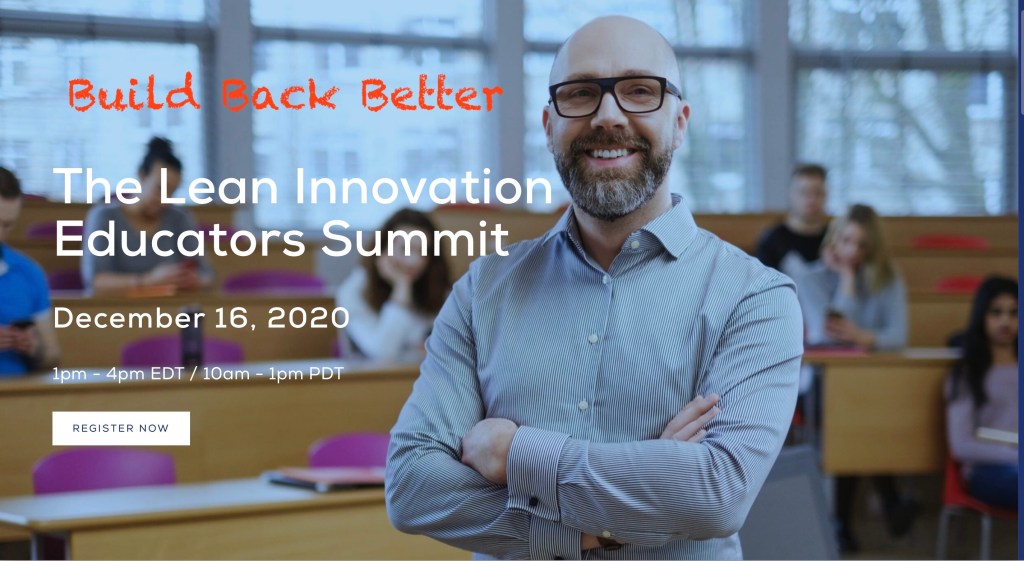[ad_1]
Jerry Engel, Pete Newell, Steve Weinstein and I invited nearly 500 Lean Educators from 63 countries and 235 universities to a three-hour session online to share what we learned from educators about how we can help our communities recover, adapt, and recover.
We received insights into tools, tips, techniques and best practices from each other.
We have learned the following:
–
Background
When we held this virtual summit for the last time in July, our 400 educators were just dealing with distance learning. The two questions on the table were: 1) Could the Lean methodology work remotely? 2) And what kind of pedagogy would support a class that depends on “getting out of the building” to work virtually? How effective would customer acquisition be tactically for the students? Would clients sit down for virtual interviews? How would you show them minimally viable products if not in person? How do you keep students busy?
This summit
This summit discussed how the pandemic has changed the way we teach, but also what we have learned and how we use the Lean method can have an impact on our communities.
COVID-19 has dramatically changed the business landscape. Main Street shops have been badly affected. While many parts of the high-tech sector are growing, others are shrinking or closing. In these uncertain times, we believe lean educators can prepare students for this new investment climate and help communities recover.
The summit opened with a group of investors who shared their insights into what the funding environment for entrepreneurs, nonprofits and small businesses will be like when the economy recovers. You can find a video of the investor panel here.
Next, Lee Bollinger, President of Columbia University, electrified the audience with a description of the fourth purpose of a university. (I have summarized our conversation with the video and the transcript of the entire lecture after the summary.)
The core of the summit was to gather the collective wisdom and experience of the 500 attendees as we split into 20 breakout rooms. In addition to sharing tips on teaching traditional entrepreneurs, we also discussed how we can help businesses on Main Street. The output of the breakout sessions provided a wealth of data, loads of useful suggestions, teaching tips, and tools. After Lee’s talk, I’ve summarized the collective notes from the breakout session.
Lee Bollinger – Columbia
The three goals of a university are research, education, and public service. However, universities should play an additional role. To try to influence and influence the world in a good way I call that the fourth purpose of a university. No university has said, “We should design the institution to be more effective through academic work, by partnering with outside institutions, organizations and partners.” And that is what the fourth purpose is about.
If you look around the world, you see these big problems, massive inequality, hunger, poverty, climate change and questions about building a global trading system. You have national problems. So there is no shortage of important topics.
NGOs play a very important role, but usually focus on a specific topic. Again, if you look at think tanks, many of them are caught up in specific interests. And universities have these incredible kinds of people who are filled with public purposes and want to make an impact in the world.
One of the things I’ve noticed throughout my career is that these people are unlikely to get credit for this work in the promotion and tenure process. And that seems crazy to me. We should include people in the appointment process who have incredible talents of this type. People who are extremely gifted and talented at making things happen in the world. I think we all knew people like that.
[If we do this] We would have a cohort of people in our institution who are equal, with the greatest scholars and the greatest teachers. But they have the greatest impact on the world. We do that to a certain extent. That’s why it’s interesting in a way. It’s not even like it’s completely new. I mean, the great surgeon, the great lawyer is going to be an adjunct in law school, or the great businessman is going to be an adjunct in business school. But we don’t take it the way I imagine it. So who do you hug at university and what do you value?
I think it’s very pragmatic and practical – where are you in your thought universities in the context of the world? Should they be far removed and only focus on teaching and science, with a civil service on the side? Or should they actively deal with problems and be willing to work with outside people and organizations?
See Columbia World Projects.
If you can’t see the video of Lee Bollinger’s talk, click here. The transcript of his talk is here.
Breakout Sessions
The essence of the summit was to gather the collective wisdom and experience of the 500 attendees as we split into 20 breakout rooms. (There was also a special breakout room for those interested in the new Hacking for Environment / Oceans course, which started this year at UCSC and UCSD.)
The breakout session output provided a wealth of data, useful suggestions, teaching tips, and tools. I’ve summarized the summary notes from the breakout session.
The consensus at our July summit, reaffirmed at that summit, was: Yes, you can teach through Zoom and “get out of the building” if you physically cannot. And it’s almost good enough. Additionally, our three hour courses, which were personally challenging, required a redesign to be taught online. Zoom fatigue was real.
General observations
The crisis accelerates certain trends. COVID has broken the myth that distance learning is problematic and not as effective.
It forced everyone to do distance learning, and a lot of people felt that for a lot of things this worked a lot better than we thought it would.
Now everyone has gone through a pivot point. Everyone has experienced disruptions and may now be more open to new ideas.
It will be a procrastination when we can return. How do you use this as a technique and not be afraid of it?
We need to remember during these troubled times that many of the skills we teach – problem solving and walking around or through the wall – are life skills that we teach. You’re not just limited to entrepreneurs.
It was a great lesson not to pretend like it was normal
Pedagogy – How we teach from a distance
Online has made it easier for teams to meet, meet mentors, and easier access to top-notch speakers.
It was pointed out the importance of actually creating a good teaching design, as well as time consuming and meaningful work up front. However, it pays to allow for much better engagement and retention.
It forces educators to become much more coherent and clear about what they want to achieve with their teams and their students.
Understand that it takes longer for people to ingest information when it is delivered online.
The flipped teaching approach – lectures as recorded homework – reduces the burden of distance learning. This allows your synchronous time to focus more on working together, both with you and with the students as instructors, but also among the students themselves.
Make each lecture available before class.
Reinforce the lectures with examples during the zoom session
We’re doing better online than ever. In courses, it’s easier to get people to take part, but it’s difficult to keep the momentum going, especially when you’re dealing with the hard part of finding customers
Overall, there is more pressure to be more entertaining
Some institutions have asked students to design the class. You choose a topic, then students design the class or help design the class
It’s really difficult to maintain that one-on-one intimacy, but zooming in was a passable and safe option.
We’ve had the faculty say that hybrid classes that teach both face-to-face and virtual at the same time are likely the most adverse learning environment
Hybrid teaching – some students physically in the classroom and others carrying online were quite detrimental to the quality of the teaching
One way to ensure that students go through the advanced materials is to have students ask a question about the material beforehand
When everything changes, we will return personally. But Zoom is just a classroom that happens to be electronic. And the breakout rooms are just a breakout, a study session, it’s just electronic. I think you can make an argument that there are more innovative and interesting ways to do this. I just don’t know what they are yet.
In-class timing
Shorten the time you will be doing things. You can no longer do a full day, you can perhaps do a maximum of three hours virtually
Break things up into very, very small pieces, bite-sized pieces, one-minute, not 20-minute presentations for teams. And microvideos so people can watch to learn things
You have to dissolve everything – 10/15 minutes, it can’t be longer
Keep everything very, very short
Make things very small even when you are all online together
The chunking concepts worked very well for students and arranged these blocks of information not in a monolith, but in a buffet to make it easier for the students to access
Make sure you get to the heart of your class and repeat, “These are the five things you will need to end this discussion.” Because at the end of the day there is a bit overwhelmed
Being overwhelmed was a running narrative
Range of the classroom
Educators can reach a much larger audience, even a global audience. And that really opened the minds of educators that they could teach not just to a single group, but to a much larger group
A worldwide audience is now possible. This is a tremendous strength and has network benefits that people couldn’t foresee
Teaching remote enabled to improve access. There were some great examples of how students in Africa could take part in programs from Australia that had never been done before
I saw us as teachers without limits. This access is really being made available to everyone now, with a much, much increased number of visitors
We can bring in more people from outside the classroom. Not just the theorists, but also the components of customer development or Main Street businesses and the local components
We are no longer tied to the size of the classroom. This year we switched from 8 teams and 32 students to 16 teams and 80 students
Guest speaker
A year ago, the students looked down on not having personal guests. Today they are overwhelmed with who we can get
Distance learning offers wider access to more visiting lecturers. It’s much easier for guests to say yes as they don’t have to drive in but can do so from their office
Pre-recording some guests gives access to guests who would normally say no based on their schedule
Customer discovery
Leaving the classroom can, in some ways, be a lot easier if you are never in a classroom. There aren’t the same travel and logistics challenges.
Getting Zoom interviews is actually easier. As a result, part of the discovery process online was easier
Mixed results: We were able to get more people to do more interviews and because people are more available online. But we couldn’t go that deep and couldn’t do more of the informal observation, the part to really get an inside look
We need to know which customer development sweet spots work best with Zoom and which don’t work best with Zoom. We need to provide better guidance to our students on this point.
Minimally viable products
The very important role that the MVP plays today, especially when you are working in zoom. If you can get the product quickly, cheaply, and without spending a lot of money, then you have to because it will take you a lot further, which you can learn from a customer development perspective.
Breakout sessions
Organize yourself to have more class time in the breakout rooms in smaller groups, because this is where engagement really takes place
Once you enter a breakout session as a professor, you will end the discussion. Be sensitive, don’t jump in, let them finish the discussion on their own
Breakout sessions held through Zoom help maintain team chemistry
If you keep the same team composition in the breakout sessions, these sessions will work very well compared to split teams
Student engagement
The wallflowers in the class can use chat as opposed to people they won’t be attending at all.
How do you generate energy during Zoom sessions, especially when making international calls?
After an hour, the engagement falls off. Basically, they just disappear from the zoom
Some of the good things were the ability to set up virtual pitching, virtual client discovery, and in some cases a specialty session hosted to motivate faculty and students
Encourage students to learn the ability to counsel one another. This is a critical skill. To be able to guide each other and say, “What did you learn about your customer discovery? And what did you learn about the value proposition? “Let them take on the role of educator a little
Cooperation
We need to find ways in which students / teams can engage in remote socialization. Find these types of activities in a way that gets the team going and make it work
Socializing is of course personal. You go out for dinner after things, you go get pizza, you hang out. It’s much more difficult virtually
Find collaboration tools that can be used both during zoom sessions and outside of class. This allows students and the entire class to interact during both official and unofficial lessons
We no longer have larger, networked discussions in which you can meet by chance at the water cooler or at the trade fair and thus increase creativity. Because of this, some of these interactions have become more meaningful and targeted because they are very focused
Providing these tools is really important because not only can they have a cup of coffee after class, but they can’t all get together at seven
Ultimately, bonding comes about when the teams meet regularly and really bond over time
Building communities is very challenging in the remote context. Although you are able to achieve many learning goals, you lack many of these intangibles
Using tools like Mural, Discord, Slack, and ClassEdu creates a sense of community and continuous collaboration
Let the students tell you which collaboration tools they are most fluent in
Team building
Teams have more problems forming and normalizing under the current circumstances
There is the shaping, storming, standardizing, doing things to teams that arise through cooperation over time and sociability
Team formations to really gel as a team can occur in such a remote environment – but it takes longer
Students / teams
Pushing more and more for diversity among students / founders; the elderly, Hispanics, women, browns and blacks – people of all tastes
Having someone who looks like this leads the class information / recruitment sessions for different students. This changes class makeup dramatically
Be sensitive to students’ personal situations
Students do not turn off their videos because they are checking out, but rather because of their location (bedroom, basement, sitting underwear, etc.).
Suggest a class rule that makes attendance part of the grade. When they speak, they have to put on the camera. This is a compromise on sensitivity
In the online environment, it’s a little more difficult to measure feedback from teams
You have to work hard to build highly dedicated and motivated teams
You want to get them to be virtual and do extreme customer discoveries
On the flip side, teams who may have started off strong at the beginning of COVID and found it easier to get things done virtually have now experienced serious virtual fatigue and are kind of decoupled and not excited about it. And just really exhausted, too exhausted to accept anything more
Mentorship
Mentoring becomes a lot easier. Instead of meeting people face to face, we can now connect people. We are able to bring in the right mentors from across the country or even from around the world to help our students mentor
There are three types of mentors; Process mentors – those who know what to expect. Technology mentors and then market mentors. It’s easier to include more people with Zoom
Reach out and find older / retired entrepreneurs and bring them into the mix as mentors, sometimes founders and trainers, etc. You have time to help
Informing mentors and investors about the video was a bit of a problem. They managed to shorten and simplify the process that helped. But questions and answers are still a bit of a struggle.
Exams
Exams need to test more understanding of the application of the concept
You can take an exam that is open for six or 24 hours. And then you can actually ask students to demonstrate more about understanding the concepts
Post-Covid teaching
How do we ensure our students who may be falling behind and may not keep up due to the COVID pandemic?
How do we make sure they are on the right track when we return?
How do we make sure we adjust to their return and a return to normal after we return?
Hauptstrasse
We, as educators, are not allowed to treat solo preneurs or companies on Main Street as second class citizens in our classrooms, incubators, or meetups. They take on the risks and challenges that big tech startups take on
Main Street customers had a product market adjustment and are now experiencing for the first time falling out of the product market adjustment
Entrepreneurs are distracted and focus on everyday problems. And they are personally affected
Looking at every aspect of the entrepreneur has been a real focus on prioritizing the human element when dealing with layoffs, cash flow issues, or potential eviction
How do we work with companies / startups that are perhaps not so much innovation-driven, but necessarily driven? Because of the upheavals and economic upheavals caused by COVID-19
How do we offer scale services to support coaching? We had some people who sent their students to help these local businesses in this time of need and turned their classes from the next step in support of the mainstream businesses
And we’ve had people doing that in both Africa and San Jose. And hacking for the Hawaiian community and going out to the countryside. However, we still struggle to get involved, especially with rural communities to help them do this
If you go to rural areas, younger people who are already fluent with the tools are more likely to get involved
Likewise, the idea is that empathy and engagement are extremely scalable. So some of the core principles here have grown very much
One of the really interesting things was connecting entrepreneurial students with waitresses and bartenders to see how they can get extra funding to make up for the lack of subsidies they might not be able to get
It’s not always a sexy company for the student to work with. But they are seeing real impact. And it’s something they can use in their project manager skills if they move on
Small Business Development Centers (SBDC) are in very strong demand for a modified Lean Launchpad curriculum program for businesses on Main Street. Each small business development center will do their best to develop a program to get you started. You are all unique. You could benefit from what universities have learned from the Lean Launchpad / Lean Startup approach
Bringing businesses online, social media literacy, and on-screen coaching has been an important job for Main Street businesses
The teams aren’t done when they’re done with the class. In fact, they start a real business while in class.
University trials
At Ryerson, the university’s incubators are open to entrepreneurs across the community, not just enrolled students.
UT Rio Grande, where many students did not have access to good internet connections, upgraded their WiFi to extend it to their parking lots
To study at the University of Buckingham, you need to create a startup before you can get your diploma. The start does not have to be successful. And if it fails soon enough, you can do another
We talked about the need to go beyond the canonical I-Corps to post curriculum after class to understand how the larger ecosystem can be part of it. We also talked about the need to track more than just team activity than just interviews. But to measure engagement with mentors and trainers. And the knowledge that comes from these commitments
Hacking for the environment and oceans
Real benefit in teaching smaller niche cohorts who are more focused on a specific problem area
All coastal universities believe that this methodology should have an impact in these areas
These courses are more complex than Hacking for Defense courses because they try to bring together a diverse community
The types of sponsors are 1) nonprofits and foundations, 2) coastal protection organizations, 2) CEOs who hope people will help them solve problems. 34) Venture funds that are starting to be impact funds, in particular. It’s a very diverse group.
For anyone interested in offering this course, see –https: //www.commonmission.us/sustainability-and-prosperityhacking-for-environment-oceans
The video of the entire breakout session reports is below.
If you can’t see the video, click here.
Executive Summary
When the National Science Foundation stopped holding its annual I-Corps Instructor Conference, we had the opportunity to create a larger community outside the NSF – now hacking too for Defense, NSIN and Lean LaunchPad educators.
When we decided to hold the online summit, we had three hypotheses:
Educators don’t just want to participate, they want to volunteer and help and learn from each other – confirmed
Instructors would care most about effective communication with students (not tools or frameworks, but the quality of engagement with students) – validated
Our educational community valued ongoing, recurring collaboration opportunities and open source ideas and tools – validated
A big thank you to Jerry Engel from U.C. Berkeley, the dean of that program. And thanks to our organizers, The Common Mission Project, who provided all of the seamless logistical support, and to sponsors VentureWell and GCEC, and to each of the leaders of the breakout room:
Ali Hawks – Joint Mission Project Great Britain, Chris Taylor – Georgetown, Philip Bouchard – TrustedPeer, Jim Hornthal – UC Berkeley, Michael Marasco – North West, Bob Dorf – Colombia, Tom Bedecarré – Stanford, Dave Chapman – University College London, Paul Fox – LaSalle Univ Barcelona, Phil Weilerstein – VentureWell, Stephanie Marrus – University of California, San Francisco, Jim Chung – George Washington University, Babu DasGupta – University of Wisconsin, Todd Warren – Northwest, Jeff Reid – Georgetown, Micah Kotch – Urban – X, Radhika Malpani – Google, Todd Basche – BMNT, Todd Morrill – VMG
Join our Slack Channel for Educators here
Save the date for our next educators summit – June 3, 2021 online.
So:
Like Loading …
Filed under: Educators Summit, Teaching |
[ad_2]



